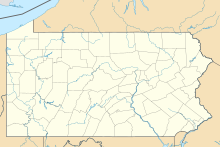Battle of East Cemetery Hill
| American Civil War | |||||||
|---|---|---|---|---|---|---|---|
| Part of Ewell's demonstration, Battle of Gettysburg | |||||||
|
|||||||
| Belligerents | |||||||
| Confederate | Union | ||||||
| Commanders and leaders | |||||||
| Richard S. Ewell | |||||||
| Units involved | |||||||
| Louisiana Tigers Brigade | |||||||
| Casualties and losses | |||||||
| Heavy | |||||||
|
|
|||||||
The battle of East Cemetery Hill during the American Civil War was a military engagement on the second day of the Battle of Gettysburg, in which an attack of the Confederacy's Louisiana Tigers Brigade and a brigade led by Colonel Robert Hoke was repelled by the forces of Colonel Andrew L. Harris and Colonel Leopold von Gilsa of the XI Corps (Union Army), plus reinforcements. The site is on Cemetery Hill's east-northeast slope, east of the summit of the Baltimore Pike.
Confederate General Robert E. Lee assigned Lt. Gen. Richard S. Ewell's Second Corps to launch a demonstration against the Union right to distract the Army of the Potomac during Longstreet's attack to the south-southwest (Hood's Assault, McLaws' Assault, and Anderson's assault). Ewell was to exploit any success his demonstration might achieve by following up with a full-scale attack at his discretion. Preceded by a 4 p.m. artillery barrage from Benner Hill, the demonstration's infantry attack commenced with Johnson's Assault on Culp's Hill. The Union artillery lunettes on East Cemetery Hill provided protection from the barrage, and the counterbattery fire on Ewell's 4 batteries forced them to withdraw with heavy casualties (e.g., Major Joseph W. Latimer).
...
Wikipedia

